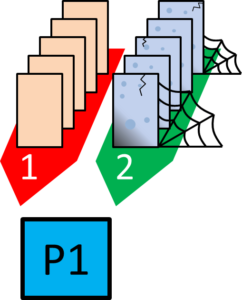 In my previous post I went through the basics of prioritization of your work orders. The easiest way to prioritize these orders is through a VIP lane: a lane for very important parts. In this post I will discuss what you need to make your VIP lane work – and how you can completely mess up a priority system. In my next post I will describe different prioritization strategies that can be used.
In my previous post I went through the basics of prioritization of your work orders. The easiest way to prioritize these orders is through a VIP lane: a lane for very important parts. In this post I will discuss what you need to make your VIP lane work – and how you can completely mess up a priority system. In my next post I will describe different prioritization strategies that can be used.
No Prioritization
 The easiest way, so to speak, is not to prioritize at all. The kanban and/or CONWIP cards are simply processed in the sequence they arrive. Hence, the processing is strictly on a first-come first-served basis.
The easiest way, so to speak, is not to prioritize at all. The kanban and/or CONWIP cards are simply processed in the sequence they arrive. Hence, the processing is strictly on a first-come first-served basis.
This is illustrated here. Depending on the physical form of the kanban (electronic, paper, box, etc.), different solutions are possible to form a queue. For commonly used rectangular paper or plastic kanban, it is often a simple slide. Hence, in the image here I sketched a green slide with a number of kanban cards on it. Newly arriving kanban are added to the back in the order they arrive. If process P1 has completed a process and needs a new work order, it simply takes the first kanban out of the system.
This system is the easiest to manage, but it has no prioritization at all.
The VIP Lane
Basic VIP Lane
 A version with prioritization needs at least two lanes. This is also shown in the image. The first lane (green) is for normal cards. The second lane (red) is the VIP lane. (Note: the term “VIP lane” is not an official name but illustrates the point well). These VIP lanes are for Very Important Production orders, similar to the gold member or the first-class lane at airport check-in.
A version with prioritization needs at least two lanes. This is also shown in the image. The first lane (green) is for normal cards. The second lane (red) is the VIP lane. (Note: the term “VIP lane” is not an official name but illustrates the point well). These VIP lanes are for Very Important Production orders, similar to the gold member or the first-class lane at airport check-in.
The operator at process P1 has the following simple priority rule: Whenever there is a card in the VIP lane, then the first card in the VIP lane is the next one to be processed; only if the VIP lane is empty should the first card of the normal (green) lane be processed.
What Do We Need to Make It Work?
 It is easy to see that this system can under certain situations get clogged up. For example, if you have not enough capacity, then the line will get longer and longer. In the worst case, you will never get around to doing a non-priority kanban.
It is easy to see that this system can under certain situations get clogged up. For example, if you have not enough capacity, then the line will get longer and longer. In the worst case, you will never get around to doing a non-priority kanban.
This, however, is not the fault of the priority system but due to insufficient capacity. Regardless of the prioritization system, if you don’t have enough capacity, you will not be able to make enough parts!
A second problem, however, may be less obvious. You may be tempted to do something good for your products by upgrading them to VIP status. However, this VIP system works only if there are not too many VIPs.
 This is the same as at the airport. If everybody is a gold member, then no one has an advantage of the membership. Or, if everybody is special, then no one is! Hence, try not to give too many cards the VIP treatment.
This is the same as at the airport. If everybody is a gold member, then no one has an advantage of the membership. Or, if everybody is special, then no one is! Hence, try not to give too many cards the VIP treatment.
Even worse, while your (many) priority orders will have only a small advantage, your few de-prioritized orders will have a much longer and – worse – a much more variable lead time.
Take for example a supermarket checkout, working on a first-come first-served basis. If there would be a VIP lane at the checkout, this would be no problem if there were only a few VIPs (although I would be terribly annoyed). However, if everybody but you is a VIP, then your checkout time becomes very long and random, since you would have to let every other customer go in front of you. Hence, a priority system only works if there are only a few prioritized orders.

In my experience, if you have 10% VIP cards, then your VIP cards have a significantly reduced lead time. Having 20% VIP cards may also still be doable, although the advantage is smaller. With 30% VIP cards, the benefit may no longer be worth the effort of a VIP lane. And again, if all cards are VIP cards, then there is even a disadvantage compared to a system without any prioritization. Hence, make only a small fraction of your products special, or there will be no positive effect for the VIP but a large negative effect for the non-VIP!
Multiple VIP Lanes
The Über-VIP Lane – Three Lanes
 Sometimes there may be a temptation to add an additional lane. After all, you have normal jobs, important jobs, and even more important jobs.
Sometimes there may be a temptation to add an additional lane. After all, you have normal jobs, important jobs, and even more important jobs.
Just like at the airport, there are silver members and higher ranking gold members – both of which of course are treated better than the regular run-of-the-mill passengers. Hence, you could add another kanban lane for those extra important Über-VIP jobs.
Please resist the temptation to add a third lane! A third even higher priority lane brings little to no benefit. The whole prioritization system aims to reduce the lead times for higher priority jobs. For this to work, the VIP lane should mostly be empty, and you should not have more than 10%-20% VIP tasks. Hence, in a two-kanban lane system, a newly arriving Über-VIP task probably would not have to wait anyway, because the VIP lane is empty.
 Even if there is a job in the VIP lane, then the Über-VIP would have to wait at most for one or two cycles more, which is usually not worth the complexity of a third Über-VIP lane. In the rare case of this being critical, just do a manager intervention and put it at the front of the VIP lane. If it happens only rarely, then it should be perfectly fine.
Even if there is a job in the VIP lane, then the Über-VIP would have to wait at most for one or two cycles more, which is usually not worth the complexity of a third Über-VIP lane. In the rare case of this being critical, just do a manager intervention and put it at the front of the VIP lane. If it happens only rarely, then it should be perfectly fine.
Overall, a third lane is rarely worth the effort of an additional rule. Hence, KISS – Keep it simple, stupid!
As for the airport example, these bronze, silver, and gold status cards on top of “normal” customers are not there to provide a significantly faster boarding for these customers; they have another purpose. It is not so much the minimal faster boarding. Instead, the customers pay for feeling special and receiving different treats. Hence, rather than reducing the lead time, these cards aim to improve profits. After all, the airplane lands at the same time with both first class and economy 😉 .
The Ultra-Über-Mega-VIP Lane – Four or More Lanes
 Having warned you against a three-lane VIP system, I must warn you even more against a system with more than three lanes. Embarrassingly, I can talk from my own experience 🙁 .
Having warned you against a three-lane VIP system, I must warn you even more against a system with more than three lanes. Embarrassingly, I can talk from my own experience 🙁 .
A long time ago I designed a priority system, and the operators in the workshop started adding more and more VIP lanes to make the priorities “clearer.” We ended up with a total of four lanes, and rather confusing rules. In the end, since the system was so confusing, the operators did whatever job they wanted to do – which was what they probably wanted in the first place. Hence, I was outsmarted by the operators (again).
Having since learned that there is pretty much no benefit for the lead time, but a large penalty through confusion, I strongly advise against too many VIP lanes. Learn from my mistakes.

This post discussed how to establish and organize a VIP lane. However, there is also the question of which tasks to prioritize. There are different strategies to prioritize your work, depending on the particularities of your production. In my next post I will discuss make-to-stock prioritization strategies, followed by make-to-order and mixed prioritization strategies. In the meantime, go out, do important tasks first, and organize your industry!

Very good article Chris, having to implement priorities based on a myriad of reasons is a common situations on many processes. It still feels like a flow countermeasure. If you had to design a process what would it ideally look like? (unrestricted)
Hi Miguel, hopefully the next two posts on this series will answer that question. Stay tuned 🙂